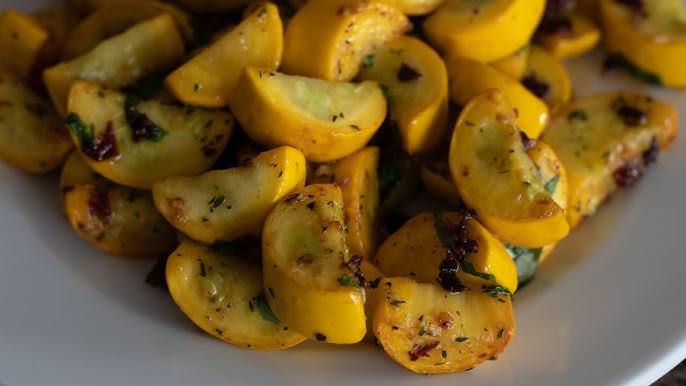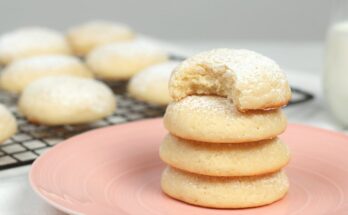Yellow Squash Recipe: If you’re looking for a vibrant, easy-to-make side dish that’s packed with flavor and nutrients, you can’t go wrong with yellow squash. This golden veggie is not only versatile but also super simple to cook with.
Whether you’re a newbie in the kitchen or a seasoned home chef, this step-by-step yellow squash recipe will help you whip up a delicious dish in no time.
Let’s jump in!
What is Yellow Squash?
Yellow squash, often seen in grocery stores during the summer, is a type of summer squash with smooth, thin, yellow skin and tender flesh. There are two main varieties: straightneck and crookneck. Both have a mild, slightly sweet flavor that makes them ideal for sautéing, roasting, grilling, or even eating raw in salads.
It belongs to the Cucurbitaceae family, just like zucchini, pumpkins, and cucumbers. Unlike winter squash, yellow squash has a shorter shelf life but cooks much faster. The best part? You don’t even need to peel it—just wash it thoroughly, slice, and it’s ready to cook.
You’ll often find yellow squash at farmers markets during late spring through early fall, making it a staple in seasonal cooking. Its soft texture allows it to absorb flavors from herbs and spices, which makes it a favorite ingredient in countless dishes.
Health Benefits of Yellow Squash
Yellow squash is more than just a colorful addition to your plate—it’s a powerhouse of nutrients. It’s low in calories but rich in essential vitamins and minerals. A one-cup serving of cooked yellow squash contains:
- Vitamin C
- Vitamin A
- Folate
- Magnesium
- Potassium
- Fiber
Because it’s low in carbohydrates and fats, it’s excellent for weight management and heart health. Plus, it’s high in antioxidants, which help protect the body from harmful free radicals.
Eating yellow squash regularly can support eye health, boost the immune system, and improve digestion. It’s also hydrating due to its high water content—perfect for hot summer meals!
Ingredients You’ll Need
Fresh Ingredients
To keep the dish fresh and full of flavor, choose high-quality produce. Here’s what you need:
- 2–3 medium yellow squash (about 1.5 pounds)
- 1 small onion (white or yellow, thinly sliced)
- 2 cloves garlic (minced)
- 1 tablespoon fresh parsley (chopped, for garnish)
The star of the show is obviously the yellow squash. Choose firm, blemish-free squash that feels heavy for its size. Avoid squash that looks wrinkled or has soft spots—it’s likely past its prime.
Adding onions and garlic gives the dish a robust flavor foundation, and a sprinkle of parsley adds a pop of color and freshness.
Pantry Staples
These common kitchen staples bring everything together:
- 2 tablespoons olive oil (or butter for a richer taste)
- Salt and pepper to taste
- ½ teaspoon dried thyme or Italian seasoning (optional)
Olive oil not only helps cook the squash evenly but adds a smooth, slightly fruity taste. Salt and pepper are must-haves for seasoning, and adding dried herbs like thyme or Italian seasoning gives the dish an aromatic flair.
Kitchen Tools and Equipment
Essential Tools
Before you start cooking, gather these kitchen tools:
- Chef’s knife – for slicing the squash and onion
- Cutting board – a sturdy surface for prep
- Large skillet or sauté pan – preferably non-stick
- Spatula or wooden spoon – for stirring
Having the right tools can make the cooking process smoother and faster. A non-stick pan is especially helpful since it requires less oil and prevents the squash from sticking or burning.
Optional Add-ons
Want to level up your kitchen game? These tools aren’t necessary but are good to have:
- Mandoline slicer – for uniform slices
- Garlic press – for finely minced garlic
- Microplane – if you want to add a bit of parmesan cheese or lemon zest on top
These small upgrades can make your kitchen experience easier and more enjoyable. Plus, they help make your dish look more polished, especially if you’re cooking for guests.
Preparing Yellow Squash for Cooking
How to Wash and Slice
Start by giving your squash a good rinse under cold running water. Use a vegetable brush if you like, but usually a simple rub with your hands does the trick.
Then, trim off both ends using a sharp knife. Slice the squash into ¼-inch thick rounds or half-moons, depending on your presentation style. Thinner slices cook faster and get a little crispier, while thicker pieces stay more tender and moist.
If you’re using older or larger squash, check for seeds. While you can cook with the seeds in, removing larger seeds can improve the texture.
Tips for Better Texture
One of the biggest challenges when cooking squash is avoiding that mushy texture. Here’s how to keep it just right:
- Don’t overcrowd the pan – Sauté in batches if needed so each slice gets a chance to caramelize.
- High heat, short time – Cook over medium-high heat and don’t overcook. The goal is a tender-crisp bite, not baby food.
- Drain excess water – If your squash releases too much liquid, drain or sauté a little longer to evaporate moisture.
Taking just a few extra minutes to prep properly can make all the difference in taste and presentation.
Step-by-Step Yellow Squash Recipe
Step 1 – Prepping the Ingredients
Start by gathering your yellow squash, onion, garlic, herbs, and pantry staples. Lay everything out on your prep station so you’re not scrambling later. Make sure your skillet is clean and dry—residual moisture can lead to uneven cooking.
Slice the squash into ¼-inch rounds or half-moons. Thin slices allow more caramelized edges; thicker ones give a softer texture. Slice the onion thinly so it cooks down but still holds shape. Peel and mince the garlic finely.
Once everything is sliced, set them aside separately—you’ll use them in a precise order to build flavor layers. Now’s a good time to pre-heat your skillet over medium-high heat. A hot pan ensures quick searing, locking in flavor and moisture.
Step 2 – Sautéing the Squash
Once the skillet is hot (you should be able to feel warmth rising off it), add 1 tablespoon of olive oil. Swirl to coat evenly. If the oil moves easily across the surface, you’re ready.
Add the squash in a single layer. Don’t overcrowd the pan—you want space so slices can sear instead of steam. Let them cook undisturbed for 2–3 minutes. Flip once golden brown edges appear, and continue cooking for another 2–3 minutes. You’re aiming for tender-crisp squash, not mush.
Remove the browned squash to a plate and tent loosely with foil so it stays warm. Wipe the skillet with a paper towel if there’s excess liquid—this resets your pan for the next steps.
Step 3 – Seasoning and Final Touches
In the still-hot skillet, add the remaining 1 tablespoon of olive oil. Toss in the sliced onion and sauté for about 4 minutes, stirring occasionally until translucent and starting to brown. Add garlic and cook another 30 seconds or until fragrant—be careful not to burn it.
Return the squash to the pan. Season with ½ teaspoon dried thyme or Italian seasoning, plus salt and pepper to taste. Gently toss to combine and warm through—this only takes about a minute. Adjust seasoning, tasting as you go. If you like brightness, squeeze a bit of lemon juice over the squash.
Finish by removing from heat and stirring in the chopped fresh parsley for freshness and color.
Serving Suggestions
What Goes Well with Yellow Squash?
The possibilities are endless! Here are some tasty pairings:
- Protein Options: Serve alongside grilled chicken breast, pan-seared fish like salmon or tilapia, or roasted pork chops. The mild squash flavor complements savory proteins well.
- Grains & Starches: Rice pilaf, quinoa, or couscous are excellent bottoms for a bed of squash. For heartier meals, mashed potatoes or crusty bread soak up the flavors.
- Salads & Light Meals: Mix cooled squash into a summer salad with cherry tomatoes, fresh basil, feta, and balsamic dressing.
- Toppings & Enhancers: A sprinkle of grated Parmesan, crumbled goat cheese, or a drizzle of browned butter adds richness. For spice lovers, toss in red pepper flakes or smoked paprika.
How to Present Your Dish
- Family-style platter: Transfer the warm squash over a large bowl or platter. Garnish with extra parsley or a wedge of lemon.
- Individual plates: Layer grain, add protein, then the squash on top or to the side. Drizzle any skillet juices over it.
- Color aesthetic: Serve with vibrant sides—like roasted beets, cherry tomatoes, or greens—to create an appealing color contrast.
Storage Tips and Leftovers
How to Store
Leftover squash keeps well:
- Let it cool at room temperature for 15–20 minutes, uncovered.
- Transfer to an airtight container and refrigerate. Use within 3–4 days.
- For longer storage, freeze in a freezer-safe container—but note the texture softens upon thawing.
Reheating Ideas
- Skillet: Reheat over medium heat until warm, adding a splash of water, broth, or olive oil to prevent drying.
- Oven: Preheat to 350°F (175°C). Place squash in an oven-safe dish, cover with foil, bake for 10–12 minutes or until heated through.
- Microwave: Cover loosely with a damp paper towel and microwave on medium power in 30-second bursts.
You can also incorporate leftover squash into other dishes: mix into pasta, omelets, tacos, flatbreads, or soups for added veggies.
Common Mistakes to Avoid
Overcooking
Yellow squash cooks quickly—overcooking leads to mushy texture and bland flavor. Aim for 4–6 minutes total in the pan. Keep slices tender-crisp, not limp mush. If you accidentally overcook, drain any excess liquid, garnish with herbs, and add cheese to salvage flavor.
Underseasoning
Squash is mild, so don’t skip salt, pepper, and herbs. Taste along the way and add more flavor boosters like garlic, fresh herbs, lemon juice, or grated cheese. A hearty Arabesque of flavor can save even slightly overcooked squash.
Crowding the Pan
Overcrowding traps steam and leads to sogginess. Cook in batches if necessary—2 lbs is ideal for a large skillet. If you must cook more, remove browned squash and continue in batches, then return everything to the pan for reseasoning and combining.
Variations of the Recipe
Want to mix things up? Try these variations:
Add Cheese or Cream
- Creamy twist: Stir in 2 tablespoons heavy cream or creme fraiche at the end, off heat.
- Cheesy delight: Sprinkle ¼ cup grated Parmesan or crumbled feta. Let it melt slightly before serving.
- Mozzarella melt: Top with sliced mozzarella and broil for 1–2 minutes—get that golden, gooey finish.
Make It Spicy
- Heat it up: Add ¼ teaspoon crushed red pepper flakes while sautéing onion and garlic.
- Smoky chipotle: Stir in 1 teaspoon chipotle in adobo or smoked paprika before combining.
- Zesty kick: Squeeze fresh lime juice and top with chopped cilantro—gives a Southwestern freshness.
FAQs about Yellow Squash Recipe
Can you eat the skin of yellow squash?
Yes! The skin of yellow squash is tender and completely edible. There’s no need to peel it—just wash it thoroughly under running water. The skin adds texture and color to the dish and contains nutrients, too.
What’s the difference between zucchini and yellow squash?
Zucchini and yellow squash are both summer squashes, but yellow squash tends to be slightly sweeter with a softer texture. Zucchini has a more uniform shape and firmer flesh. They can be used interchangeably in many recipes, though yellow squash is better suited for dishes where a softer texture is desired.
Can I grill yellow squash instead?
Absolutely! Yellow squash grills beautifully. Slice it lengthwise or into thick rounds, brush with olive oil, sprinkle with salt and pepper, and grill over medium-high heat for 2–3 minutes per side. It gets a delicious smoky flavor and char marks.
How long does cooked squash last in the fridge?
Cooked yellow squash lasts about 3–4 days when stored in an airtight container in the refrigerator. For best texture and flavor, consume it within 48 hours. You can also freeze it, but note the texture may soften upon reheating.
Is yellow squash keto-friendly?
Yes, yellow squash is keto-friendly. It’s low in carbs and high in fiber, making it suitable for low-carb and keto diets. One cup of cooked yellow squash contains roughly 4–5 grams of net carbs. Pair it with healthy fats and proteins for a satisfying keto meal.
Conclusion
There you have it—a complete, foolproof guide to making delicious yellow squash from scratch! This veggie might seem humble at first glance, but once you sauté it up with onions, garlic, herbs, and a splash of creativity, it transforms into a dish that’s comforting, healthy, and downright tasty.
So the next time you’re strolling through your local farmers market or grocery store and spot those bright yellow squash, grab a few and give this recipe a go. With just a handful of ingredients and a hot skillet, you’ll have a restaurant-worthy dish that even picky eaters will love.
Cooking with seasonal vegetables like yellow squash doesn’t just taste better—it also supports local growers and boosts your nutrition naturally. So embrace this sunny veggie, and let it shine on your table all season long!



